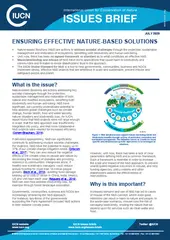About Nature-based Solutions for climate
The Paris Climate Agreement commits to keep global warming below 2°C and to pursue efforts to limit warming to 1.5°C. The actions of the international community between now and 2030 will determine whether we can collectively slow warming enough to avoid the worst impacts of climate change.
Above the 1.5 °C limit, the risks of extreme weather and collapsing ecosystems grow. The latest IPCC report demonstrated that nature-based solutions such as reducing the destruction of forests and other ecosystems, restoring them, and improving the management of working lands, such as farms — are among the top five most effective strategies for mitigating carbon emissions by 2030.
Nature-based Solutions for both mitigation and adaptation serve as an integral piece of the required global response for climate action.
Nature-based solutions can address climate change in three ways:
- Decrease greenhouse gas emissions related to deforestation and land use
- Capture and store carbon dioxide from the atmosphere
- Enhance resilience of ecosystems, and as such support societies to adapt to climate hazards such as flooding, sea-level rise, and more frequent and intense droughts, floods, heatwaves, and wildfires.













